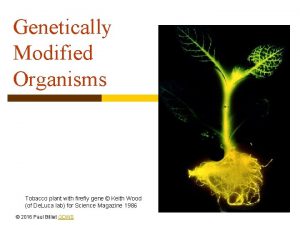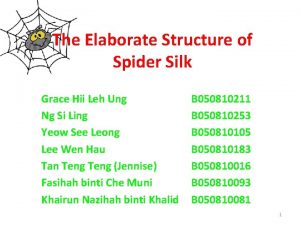Synthetic Spider Silk Production in Alfalfa Cameron L

- Slides: 1

Synthetic Spider Silk Production in Alfalfa Cameron L. Brock, Michaela R. Hugie 1, Holly Steinkraus 2, and Randolph V. Lewis 1 Department of Biological Engineering 1, Utah State University. Department of Molecular Biology 2, University of Wyoming. Spider Silk Agrobacterium Transformation . (-) Plant #52 (+) MW As is seen in Figure 5, the recombinant spider silk is being expressed in the Agrobacterium transformed Plant #52 at 80 k. Da, according to analyses by band detection on Lab 3. 0. The negative control was a R 2336 Medicago alfalfa plant that was Figure 5: Western run to determine expression of spider silk in alfalfa. transformed with an empty R 111 vector, and the positive western blot control is (A 2 S 8)14 , a synthetic Ma. Sp 2 protein expressed in E. coli. All plants that have been tested have shown expression of the synthetic Ma. Sp 2 construct, although a yield has not yet been determined. Figure 1: Diagram of spider silk glands. Spider silk is one of the strongest natural fibers known. There are many types of spider silk proteins, produced in different glands to serve a variety of specific functions. The strength of some spider silks, such as dragline silk, is comparable to that of high-grade steel. Spider silk not only has high tensile strength, but it also is highly elastic and capable of maintaining mechanical properties over a broad range of temperatures and tensions. Thus, spider silk has the potential for applications in several areas, including: air bags, bulletproof materials, artificial ligaments and tendons, and textiles. Due to the aggressive nature of the spiders, producing the amount of silk needed for these applications would be impossible. Therefore, there is a need for a synthetic spider silk process. To date synthetic spider silk has been produced in E. coli, goats, silkworms, yeast, and alfalfa. Why Alfalfa? The two limiting factors currently faced in synthetic spider silk protein production are yield and protein size, which is proportional to the mechanical properties. Alfalfa provides a solution to both of these issues. Alfalfa is a perennial crop that is capable of producing up to an estimated 55 kg of protein per acre per year. Alfalfa naturally produces proteins on the same size scale as the natural spider silk protein, 250 -300 k. Da. An additional benefit is that the majority of spider silk protein is expressed in the leaves of the plants; therefore, the remaining plant tissue. such as the stalks, may be used as livestock feed or ethanol production. This removes any costs of waste removal and provides a secondary revenue. Current Results Figure 2: Agrobacterium tumefacien’s mode of action for transforming plants. http: //mol-biol 4 masters. grkraj. org/ Transgenic Alfalfa Figure 3: Callus tissue resulting from an agrobacterium transformation with a spider silk gene. As callus develops on nutrient-rich agar, leaflets and small roots will begin to form. Future Endeavors It is currently impossible to accurately determine yield size due to interference in extraction and purification by the charged chlorophyll proteins. To precisely extract and purify the spider silk protein all chlorophyll must be removed. Current chlorophyll removal methods, such as those used in biofuels, are too harsh and will cause protein degradation; therefore a new method of chlorophyll removal is needed to further processing. Contributors Figure 4: Transgenic alfalfa with a developed root system. Once plant size increases the plant will be transplanted into soil. The leaves are harvested and the spider silk protein extracted. The following agencies and individuals should be acknowledged for the funding and efforts which make this research possible: USTAR (Utah Science Technology and Research), DOE (Department of Energy), AFOSR (Air Force Office of Scientific Research), and USU Research Scientists: Justin Jones and Michael Hinman

